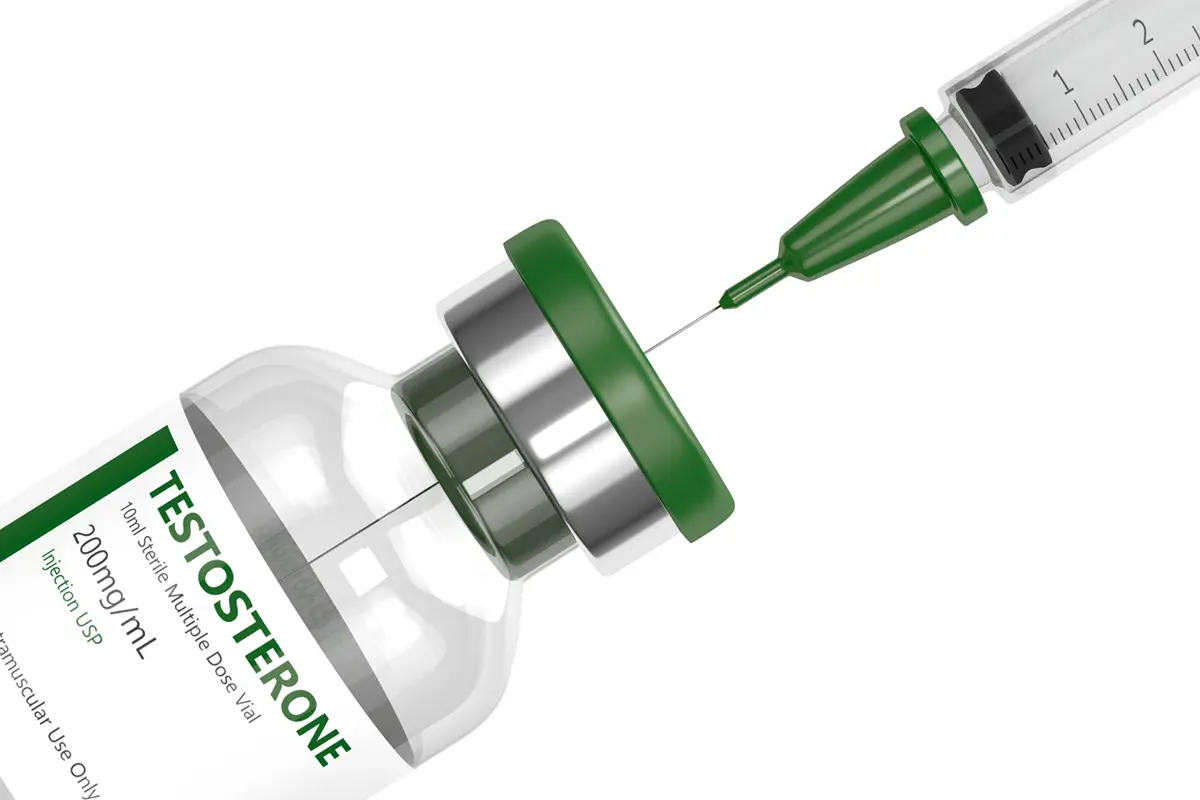
Written by
Gabriel Alizaidy, MD, MS
For decades, intramuscular testosterone injections have been the standard of care. They are what most early studies used, what most training programs teach, and what many patients still receive today. The method works, but as understanding of pharmacology and tissue physiology has improved, another option has gained attention: subcutaneous injection, or simply “SubQ.”
SubQ testosterone is injected just beneath the skin rather than deep into muscle. At first, it was seen as a matter of convenience. Now, research shows it is just as effective, and in some cases more consistent, especially when paired with smaller, more frequent doses.
This article explains how and why the two routes differ, what the studies show, and why the details of frequency, oil type, and needle size can make a real difference in comfort and hormone stability.
The Role of Testosterone Esters
Testosterone in its natural form is quickly broken down in the bloodstream. To make it last longer, the hormone is chemically linked to fatty acid chains called esters. These esters slow the release of testosterone from the injection site and extend its half-life.
The two most common esters in modern therapy are testosterone cypionate (TC) and testosterone enanthate (TE). Both last about a week in circulation and are typically administered once or twice per week. Their pharmacokinetics are nearly identical, though cypionate may have a slightly longer tail.
An older formulation, testosterone undecanoate (TU), was designed to last much longer, often up to 10 or 12 weeks. It is suspended in a thick castor oil vehicle that holds a large 4 mL volume of medication. Because of its viscosity and injection depth, TU requires a large 19- or 21-gauge needle and must be administered slowly by a healthcare provider.
These factors made it less practical for self-administration. The large oil volume can cause soreness at the injection site, and the long gap between doses often results in hormone fluctuations toward the end of each cycle. Some patients experience symptoms as testosterone levels drift downward before their next scheduled injection.
Shorter-acting esters like TC and TE have largely replaced TU in most clinical settings. They are easier to adjust, more compatible with self-injection, and better suited for maintaining stable hormone levels through smaller, more frequent doses.
Understanding Injection Sites
Intramuscular (IM) injections deliver testosterone deep into the muscle tissue, most commonly the glute, thigh, or deltoid. Muscles are dense and have rich blood flow, which means the hormone enters circulation quickly. Levels typically rise within a day and begin to taper by the end of the week.
Subcutaneous (SubQ) injections go into the fatty layer beneath the skin. This tissue has fewer blood vessels but a network of lymphatic channels that move hormones into the bloodstream slowly and steadily. Absorption happens over days rather than hours, which naturally smooths the hormone curve.
In short, IM injections act like a quick-release system, while SubQ behaves more like a slow, sustained release. Both reach the same total exposure over time, but the pattern of delivery feels different in practice.
The Lymphatic System and Absorption
The lymphatic system is central to how SubQ testosterone is absorbed. Unlike veins, which move blood with each heartbeat, lymphatic vessels rely on two mechanisms.
- Intrinsic pumping: smooth muscle in the vessel walls contracts rhythmically, moving lymph at a steady pace.
- Extrinsic pumping: movement of nearby muscles or skin pressure helps propel lymph forward.
This system is slow, predictable, and unaffected by how active the injected area is. By contrast, IM injections can absorb faster if the muscle is exercised soon after, making release rates slightly less consistent.
The steady movement of lymph explains why SubQ testosterone creates smooth, stable hormone levels. It is not a burst into the bloodstream, but a gradual diffusion into circulation.
Key Pharmacokinetic Concepts
Pharmacokinetics describes what happens to a drug once it enters the body. Several terms help explain why different routes feel different.
- Cmax (peak): the highest blood concentration after an injection.
- Tmax: how long it takes to reach that peak.
- Trough: the lowest point before the next injection.
- Half-life: how long it takes for levels to fall by half.
- AUC (area under the curve): total drug exposure over time.
Intramuscular injections tend to produce a sharp Cmax and a lower trough, which means more fluctuation week to week. SubQ injections produce a flatter curve: smaller peaks, higher troughs, and more time in the middle of the ideal range.
In daily life, that difference translates into more consistent mood, energy, and libido between doses.
Frequency: The True Differentiator
The smoothness of testosterone levels depends as much on how often injections are given as on where they go.
Traditional schedules used large IM doses every 1 or 2 weeks. Those intervals were designed for convenience, not physiology. The result is a rollercoaster effect: levels climb high soon after injection, then drop sharply before the next one.
Smaller, more frequent doses produce steadier results. Injecting every 3 or 4 days, or even microdosing daily, keeps peaks and troughs close together. SubQ delivery makes this easier because the smaller needles and lower pain make frequent injections practical.
Frequent dosing also helps regulate estradiol and dihydrotestosterone (DHT) levels. When testosterone rises and falls sharply, these metabolites fluctuate too. Keeping the curve flat helps minimize symptoms like irritability, water retention, or transient acne that sometimes accompany large hormonal swings.
What Clinical Studies Show
Several trials have compared SubQ and IM testosterone delivery.
In 2015, Kaminetsky et al. studied subcutaneous testosterone enanthate delivered weekly using a prefilled autoinjector. Serum testosterone levels remained in the healthy range between 400 and 900 ng/dL, with minimal variation between injections. DHT and estradiol stayed stable, and pain was reported as negligible.
In 2017, Spratt et al. conducted a similar study using weekly SubQ testosterone enanthate. Serum testosterone remained in the target range, matching results previously achieved with intramuscular injections. Participants reported easier self-administration and less post-injection soreness.
Finally, Turner et al. (2019) compared subcutaneous and intramuscular testosterone undecanoate directly. Both routes produced equivalent testosterone, estradiol, and DHT levels. The SubQ route had a slower rise to peak but matched the overall exposure and duration. The study concluded that SubQ testosterone was pharmacokinetically equivalent and a viable alternative for patients who prefer it.
Across all studies, the pattern is consistent: SubQ testosterone achieves the same hormone levels as IM injections, with less fluctuation and better comfort.
DHT, Estradiol, and Conversion Myths
A common concern is that SubQ injections increase aromatization or 5α-reduction, leading to higher estradiol or DHT levels. The data do not support this.
Aromatase and 5α-reductase enzymes are distributed throughout the body, not concentrated in fat tissue alone. Multiple studies show that estradiol and DHT levels are similar regardless of whether testosterone is delivered SubQ or IM.
If anything, SubQ injections paired with frequent dosing may reduce sharp rises in these hormones by avoiding large serum spikes. This contributes to steadier mood and fewer estrogen-related side effects.
Why Grapeseed Oil Matters
Carrier oil can make a big difference in comfort and injection quality. Grapeseed oil (GSO) is one of the best options for SubQ testosterone because of its low viscosity. It flows easily through fine 30- or 31-gauge needles and requires less pressure to inject.
GSO also disperses evenly in tissue, reducing the risk of lump formation or prolonged soreness. Because it is a lighter oil, it works well for frequent, small-volume injections and minimizes clogging or back pressure in the syringe.
For clinics offering SubQ testosterone therapy, GSO-based formulations combine pharmacologic consistency with ease of use. It is one of the main reasons small, frequent injections are practical for long-term patients.
Tissue Health and Long-Term Tolerance
Repeated deep muscle injections can eventually cause mild scarring or fibrotic areas. This is rarely serious but can make later injections less comfortable. SubQ injections avoid this by keeping the muscle intact.
For men taking anticoagulants or with bleeding risks, SubQ delivery is also safer. The fine needles and shallow depth mean less chance of bruising or hematoma. Over time, this method preserves tissue health while maintaining reliable hormone absorption.
How Do I Decide Which Is Better for Me?
Both intramuscular and subcutaneous testosterone achieve healthy hormone levels, but the experience of using them can feel very different.
If you are comfortable with deeper injections, don’t mind using larger needles, and are receiving care in a clinic setting, intramuscular testosterone is a tried-and-true choice. It works well and has decades of research behind it.
If you prefer smaller needles, easier self-administration, and a steadier hormonal rhythm, subcutaneous injections may be a better fit. They are easier to perform at home, more comfortable for frequent dosing, and work especially well when formulated in grapeseed oil.
The best approach is the one you can stay consistent with. Testosterone therapy is about balance and stability, not just numbers on a lab test. The route, frequency, and oil type all play a role, and the right combination will feel sustainable week after week.
References
Kaminetsky, J., Jaffe, J. S., & Swerdloff, R. S. (2015). Pharmacokinetic profile of subcutaneous testosterone enanthate delivered via a novel, prefilled single-use autoinjector: A phase II study. Sexual Medicine, 3(4), 269–279. https://doi.org/10.1002/sm2.80
Spratt, D. I., Stewart, I. I., Savage, C., Craig, W., Spack, N. P., Chandler, D. W., Spratt, L. V., Eimicke, T., & Olshan, J. S. (2017). Subcutaneous injection of testosterone is an effective and preferred alternative to intramuscular injection. The Journal of Clinical Endocrinology & Metabolism, 102(7), 2349–2355. https://doi.org/10.1210/jc.2017-00329
Jayadev, V., Conway, A., & Handelsman, D. J. (2019). Pharmacokinetics and acceptability of subcutaneous injection of testosterone undecanoate. Journal of the Endocrine Society, 3(8), 1531–1540. https://doi.org/10.1210/js.2019-00134




